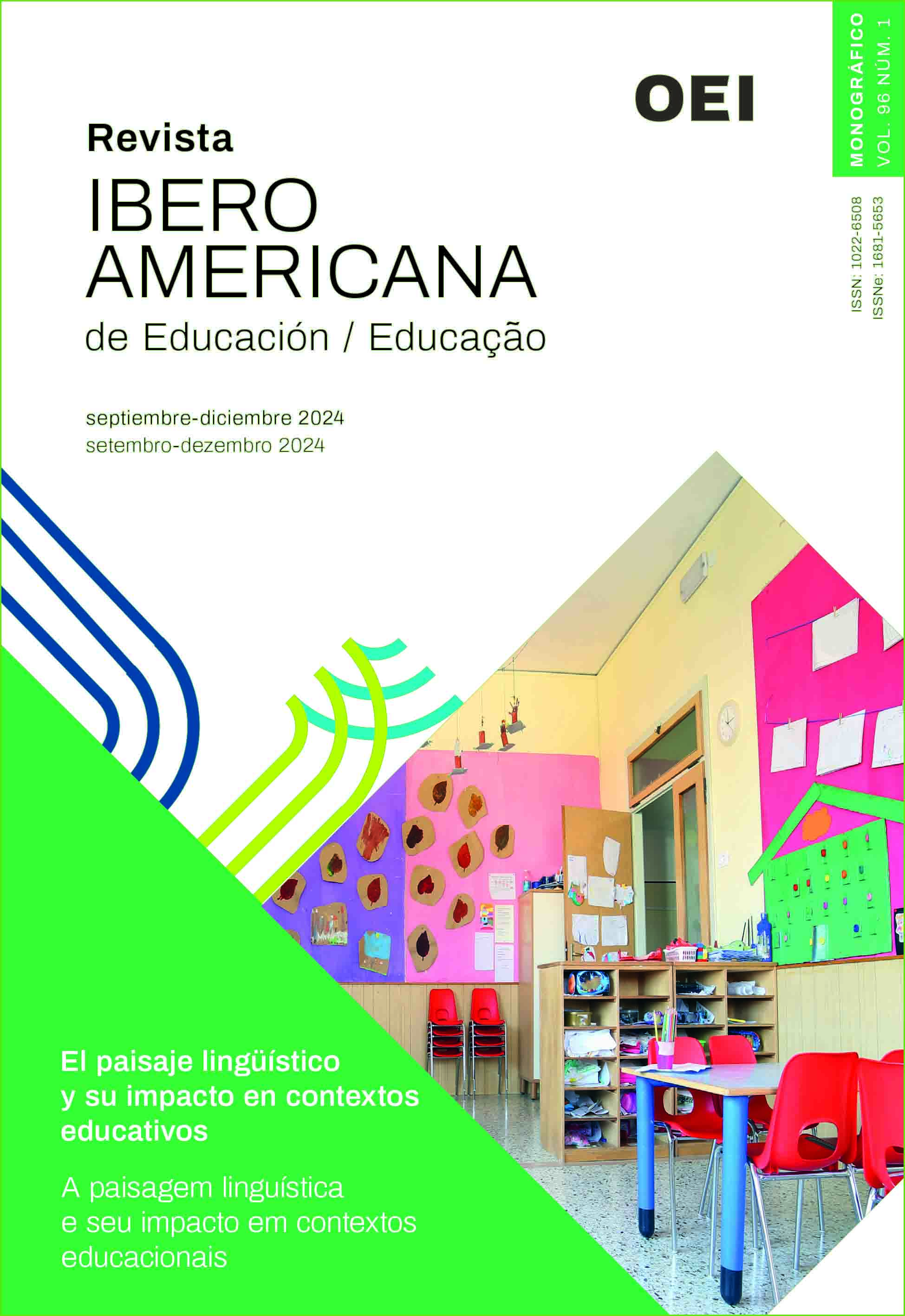Paisagem em línguas indígenas para o ensino e fortalecimento da identidade nas escolas indígenas de Oaxaca, México
DOI:
https://doi.org/10.35362/rie9616445Keywords:
Indigenous linguistic landscape, community education, language teaching, identity, cultural memoryAbstract
The linguistic landscape in indigenous educational contexts motivates indigenous language teaching processes and strengthens the cultural identity of the wider educational community. In Oaxaca, Mexico, teachers in indigenous education (preschool, kindergarten, and primary) develop different types of linguistic landscapes as bilingual, community, and intercultural pedagogical tools. This paper describes the types of linguistic landscapes produced by indigenous teachers to strengthen their teaching processes in the indigenous language and promote identity in the classrooms of indigenous schools in this state. A qualitative approach is used to analyse some images of the linguistic landscape that primary teachers had produced and the characteristics of each case. The results show that three types of landscapes stand out: 1) promoting the learning of school subjects in the indigenous language, 2) developing alphabetic writing in the indigenous language, and 3) strengthening cultural and community knowledge. It concluded that, in Oaxaca, the linguistic landscape as a pedagogical tool in the classrooms of indigenous schools emerges from the contextual needs of the teachers and, thanks to their community pedagogical work, these landscapes are constantly updated and include an infinite variety of signs.
Downloads
References
Anthony‐Stevens, V., & Gallegos Buitron, E. (2023). Indigenous Mexican Teachers and Decolonial Thinking: Enacting Pedagogies of Reclamation. Anthropology & Education Quarterly, 54(2), 144-164. https://doi.org/10.1111/aeq.12450 DOI: https://doi.org/10.1111/aeq.12450
Bracho, C. A. (2024). Demanding Justicia: the justice orientations of Oaxaca’s Sección 22 teachers. Globalization, Societies and Education, 1-15. https://doi.org/10.1080/14767724.2024.2341958 DOI: https://doi.org/10.1080/14767724.2024.2341958
Briseño-Roa, J. (2023). Indigenous land-based education in Mexico: practices to perpetuate communal knowledge of territory. AlterNative: An International Journal of Indigenous Peoples, 19(3), 593-602. https://doi.org/10.1177/11771801231188181 DOI: https://doi.org/10.1177/11771801231188181
Córdova-Hernández L. (2019). Construcción de acervos multimodales en lenguas indígenas: grafocentrismo, lectoescritura y procesos identitarios. Chuy. Revista de estudios literarios latinomaericanos, 6(6), 83-106. https://go.oei.int/wbhi9tre
Córdova-Hernández, L. (2021). Geosemiótica y orden de interacción en comunidades indígenas de reciente creación. Confluenze. Rivista di Studi Iberoamericani, 13(2), 289-319. https://doi.org/10.6092/issn.2036- 0967/12557
Córdova-Hernández, L., Valtierra Zamudio, J, & López Gopar, M. E. (2024). Comunidades indígenas. En E. Gironzetti & M. Lacorte (Eds.). The Routledge Handbook of Multiliteracies for Spanish Language Teaching (pp. 403-416). Routledge. DOI: https://doi.org/10.4324/9781003190615-32
Delgado-Gastélum, G., Tinajero-Villavicencio, M. G., & Carrasco-Altamirano, A. C. (2023). Initial Literacy: pedagogical Decisions and Definitions of a Teacher to Promote Oral and Written Language in an Indigenous Preschool. Revista Electrónica Educare, 27(1), 298-316. https://dx.doi.org/10.15359/ree.27-1.14464 DOI: https://doi.org/10.15359/ree.27-1.14464
Fernández Sepulveda, J. L. (2018). Promoción de la lengua triqui en el aula. Una experiencia colaborativa en la Escuela Primaria Bilingüe Cuauhtémoc en San Andrés Chicahuaxtla, Oaxaca. [Tesis de maestría]. Universidad Autónoma de Querétaro.
Ferreiro, E. (1998). Alfabetización teoría y práctica. Siglo XXI Editores.
Gorter, D., & Cenoz, J. (2024). Education. En R. Blackwood, S. Tufi & W. Amos (eds.). The Bloomsbury Handbook of Linguistic Landscapes (pp. 171-186).
Bloomsbury Academic.
Huebner, T. (2016). Linguistic landscape: History, trajectory and pedagogy. Manusya: Journal of Humanities, 19(3), 1-11. https://doi.org/10.1163/26659077-01903001 DOI: https://doi.org/10.1163/26659077-01903001
Krompák, E., Camilleri Grima, A., & Farrugia, M. T. (2020). A visual study of learning spaces in primary schools and classrooms in Switzerland and Malta: the relevance of schoolscape studies for teacher education. Malta Review of Educational Research, 14(1), 23-50. https://cutt.ly/feUPlbge
Malinowski, D. (2024). Language Learning. En R. Blackwood & Un Røyneland (eds.). The Bloomsbury Handbook of Linguistic Landscapes (pp. 235–251). Bloomsbury.
McCarty, T. L., & Baker, S. (2023). Indigenous Revitalization-Immersion Education in Native American Settings. En A. Freire, J., Alfaro, C., & de Jong, E. (Eds.). The Handbook of Dual Language Bilingual Education (pp. 348-359). Routledge. DOI: https://doi.org/10.4324/9781003269076-30
Meyer, L. M. (2016). Teaching our own babies: Teachers’ life journeys into community-based initial education in indigenous Oaxaca, Mexico. Global Education Review, 3(1), 5-26. https://ger.mercy.edu/index.php/ger/article/view/181
Meyer, L. M. (2018). “Carrying on The Word That I Know”: Teacher-Community Language Revitalization Collaborations in Indigenous Oaxaca, Mexico. En Hinton, L., Huss, L., & Roche, G. (Eds.). The Routledge handbook of language revitalization (pp. 384-394). Routledge. DOI: https://doi.org/10.4324/9781315561271-49
Ramírez Bustillos, A. L. (2024). Promoción y fortalecimiento de una lengua indígena en el tercer grado de educación primaria. Ralámuli como difusión cultural en escuelas mixtas. [Tesis de maestría]. Universidad Autónoma de Chihuahua.
Sagi-Vela, A. (2024). La eficacia simbólica de la escritura en lenguas de tradición oral: Un acercamiento etnográfico al caso del ayuuk en México. Altre Modernità, (31), 425-439. https://doi.org/10.54103/2035-7680/23201 DOI: https://doi.org/10.54103/2035-7680/23201
Sánchez Tyson, L. S. (2024). ‘Learning to read and write is to defend yourself’: Exploring Indigenous perspectives and reimagining literacies for self-determination in Mexico. International Journal of Educational Development, 106, 102992. https://doi.org/10.1016/j.ijedudev.2024.102992 DOI: https://doi.org/10.1016/j.ijedudev.2024.102992
Seals, C. A. (2020). Classroom translanguaging through the linguistic landscape. En D. Malinowski, H. H. Maxim & S. Dubreil (eds.). Language teaching in the linguistic landscape: Mobilizing pedagogy in public space (pp. 119-141). Springer International Publishing. DOI: https://doi.org/10.1007/978-3-030-55761-4_6
Shohamy, E. & Pennycook (2021). Language, Pedagogy, and Active Participant Engagement. Gaze in the Multilingual Landscape. En R. Blackwood & Un Røyneland (eds.), Spaces of Multilingualism (pp. 32-47). Routledge. DOI: https://doi.org/10.4324/9781003125839-4
Vega-Villalobos, B. L. & Arán-Sánchez, A. (2023). Proceso de alfabetización inicial en estudiantes tarahumaras de una escuela primaria indígena: estrategias, materiales e incidencia del contexto. Revista Ra Ximhai, 19(2), 15-34. hhttps://cutt.ly/TeUPzipC DOI: https://doi.org/10.35197/rx.19.02.2023.01.bv
How to Cite
Published
Issue
Section
License
Copyright (c) 2024 Iberoamerican Journal of Education

This work is licensed under a Creative Commons Attribution 4.0 International License.
Any authors who publish with this journal accept the following terms:















